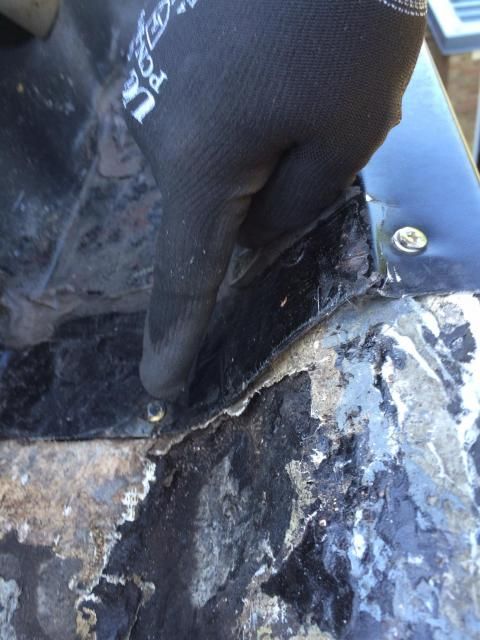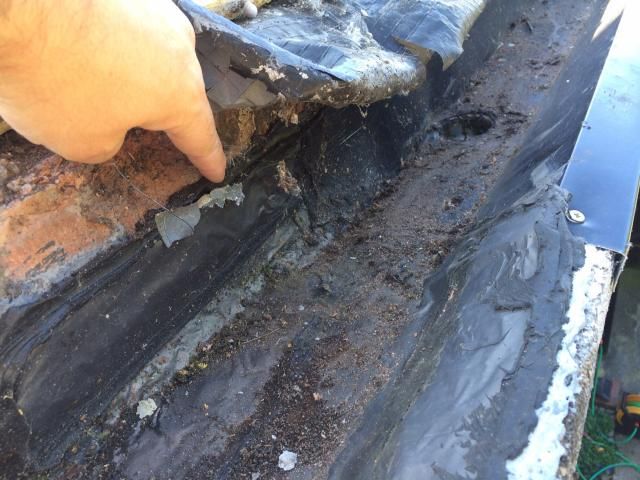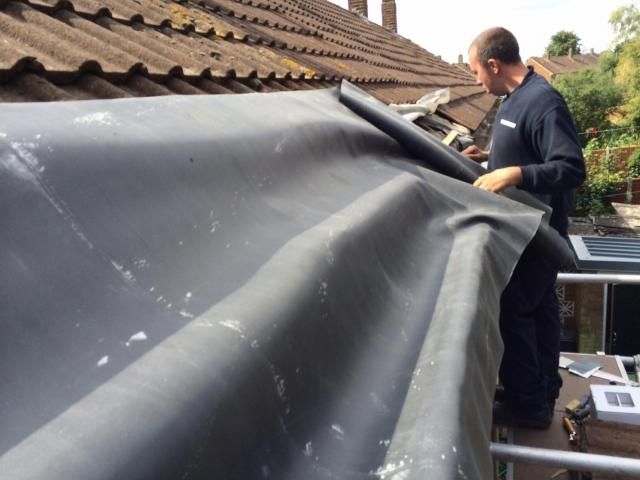Insulating to the inside is not necessary. If the concrete gutters are being removed, insulation can be placed over the backboard. Insulation is far more effective when placed to the outside rather than the inside.
You are using an out of date browser. It may not display this or other websites correctly.
You should upgrade or use an alternative browser.
You should upgrade or use an alternative browser.
Finlock Gutters reline or remove?
- Thread starter 098Joe
- Start date
I strongly support the comment above me! I have experience using these gutters and I can say the same thing as the person above me. Good luck!
I have this problem has well, and as i am a first time buyer i can't afford to have the concrete guttering replaced, but i was thinking i could fiberglass it all the away across and then floatcoat it (gel) do you think this would work?
NO
Fibreglass is a brittle, hard, non-elastomeric product. It is useless to line a finlock gutter. Within 5 years it will split, crack or come away from the concrete, water will get in behind, and your problems will be worse than before - wasting your money.
My advice would be as follows
1) Removal - Removal is a very skilled, lengthy and thus expensive job IF DONE PROPERLY. There are a lot of cowboys out there (I am sure no poster on this forum is included in that of course) who just hack off the gutter and fit fascias and a new uPVC gutter in it's place. Some of the work I've seen is appalling, and at least one company has been on Watchdog. If you are shopping around for the cheapest quote to remove the finlock, you are going to seriously come unstuck, because cheapest is NOT the way to go here! Only use someone for this kind of work who's highly reputable - and ideally members of Trading Standards Buy With Confidence scheme or the Which? Trusted Traders scheme.
2) Lining. As mentioned here elsewhere, you can get a plygene lining. This should work (not if the problem is condensation but if it's a leak) but again must be carried out by an expert.
3) A proper, FULLY elastomeric seamless liner. Ideally on a semi, you AND your neighbour(s) should always have the work done together, otherwise no matter what you do there will always be a join, or edge somewhere. If you use an "off the shelf" product, be prepared to re-do / check annually - there are products available that should last 30-50 years + but they tend to only be sold to professional installers.
Whatever you do don't buy on price with this job, buy on a company that CAN do what they say, not one who CLAIMS to do what they say.
Since you've raised the dead I'll put in my 2p's worth
We must have done 4 jobs this month all in the Luton area where they paid 1000's to have an aluminium liner installed by a gutter lining company I won't name. It does the job to an extent but look at the dogs dinner fitting.
Screws and rivets at regular intervals on the base of the liner. They dab over with silicone to seal it! Also they drill and plug the front liner to the top of the gutter so there is another place water can get in.

Now look where the liner goes to? The back of the gutter, so what happens if the existing felt drops short of the gutter or water gets through either the top of the first and second row of tiles or even if the gutters filled right up to the top of water? (Concrete gutters don't have very big outlets and they can block easily)

Now let's line it properly, 3 tiles up and 2 inches down the front face without using any nails or screws

We must have done 4 jobs this month all in the Luton area where they paid 1000's to have an aluminium liner installed by a gutter lining company I won't name. It does the job to an extent but look at the dogs dinner fitting.
Screws and rivets at regular intervals on the base of the liner. They dab over with silicone to seal it! Also they drill and plug the front liner to the top of the gutter so there is another place water can get in.

Now look where the liner goes to? The back of the gutter, so what happens if the existing felt drops short of the gutter or water gets through either the top of the first and second row of tiles or even if the gutters filled right up to the top of water? (Concrete gutters don't have very big outlets and they can block easily)

Now let's line it properly, 3 tiles up and 2 inches down the front face without using any nails or screws

Totally agree - that first job is a bodge well and truly.
The second looks a proper job - is that EPDM you're using there? Something like Firestone or Plygene?
We can do either the EPDM liner or our elastomeric coating.
They are both excellent, the liquid coating has the benefit of becoming totally seamless once cured, and both systems will last a lifetime.
But that's what happens when you get a proper job done for the customer.
The second looks a proper job - is that EPDM you're using there? Something like Firestone or Plygene?
We can do either the EPDM liner or our elastomeric coating.
They are both excellent, the liquid coating has the benefit of becoming totally seamless once cured, and both systems will last a lifetime.
But that's what happens when you get a proper job done for the customer.
I wish I had found this topic earlier!
My house is one of a pair of semis with Finlock gutters, which drain out at my neighbour's end. There has been a lot of leaking from the 'stop end' block on my house for quite some while, but recently the problem has spread to the adjacent 2 or 3 mortar joints, with water running down the face of the wall. Also quite a bit of damp/condensation in the cupboard which is in the bedroom inside the corner of the house.
Several houses in the road, including my neighbour, had aluminium liners fitted about ten years ago. They seem quite effective, tho' one person has reported a couple of minor leaks. The firm which did the work has long since gone out of business. Another house had what seems to have been a felt-and-torch job done about 2 years ago. Another house is currently having plygene lining installed - in the pouring rain!! - even as I write, but as the owner is away I won't be able to talk to him about it for a while.
It is clear that I must do something so, but what? I would rather go for the aluminium or plygene lining approach, as it seems less drastic/invasive than cutting-back the finlocks. Can this sort of job really be done well in wet weather??? - I had been assuming that I would have to wait until spring at least. [It does not help that my neighbour is a lazy so-and-so who can't be bothered to keep his downpipe clear, so the water often backs up in the gutter and in heavy rain overflows along the front - GRRR]
Any comments/advice welcome!
[/u]
My house is one of a pair of semis with Finlock gutters, which drain out at my neighbour's end. There has been a lot of leaking from the 'stop end' block on my house for quite some while, but recently the problem has spread to the adjacent 2 or 3 mortar joints, with water running down the face of the wall. Also quite a bit of damp/condensation in the cupboard which is in the bedroom inside the corner of the house.
Several houses in the road, including my neighbour, had aluminium liners fitted about ten years ago. They seem quite effective, tho' one person has reported a couple of minor leaks. The firm which did the work has long since gone out of business. Another house had what seems to have been a felt-and-torch job done about 2 years ago. Another house is currently having plygene lining installed - in the pouring rain!! - even as I write, but as the owner is away I won't be able to talk to him about it for a while.
It is clear that I must do something so, but what? I would rather go for the aluminium or plygene lining approach, as it seems less drastic/invasive than cutting-back the finlocks. Can this sort of job really be done well in wet weather??? - I had been assuming that I would have to wait until spring at least. [It does not help that my neighbour is a lazy so-and-so who can't be bothered to keep his downpipe clear, so the water often backs up in the gutter and in heavy rain overflows along the front - GRRR]
Any comments/advice welcome!
[/u]
No it has to be done in the dry!!
And ideally over 10deg for the glue but you can get away with a bit less
And ideally over 10deg for the glue but you can get away with a bit less
No it has to be done in the dry!!
And ideally over 10deg for the glue but you can get away with a bit less
Glue? I took a look at the 'training video' from HDSharman and that seemed to suggest that the overlaps etc were heat-sealed by what looked like a giant soldering iron. Did I get that wrong?
Looking at that video, and the photo on the early posting, and having seen a bit more of the 'work in progress' (now finished) on the house nearby, one thought came to me about something which I don't think has been mentioned here before. If the plygene is pushed up under the first (say) two rows of tiles, then OK - no chance of water blowing over the top of it into the roof. But what about ventilation?
Most DIY guides to guttering etc suggest providing ventilation holes at intervals in the soffit boards. Clearly not possible with finlock gutters, but at the moment at least there is some passage of air up under the bottom row of tiles. What happens when effectively it is all sealed off with the plygene???
- Joined
- 30 Jan 2011
- Messages
- 23
- Reaction score
- 0
- Country

I moved to Poole (south coast) in April and have gradually redecorated the house (ex LA semi) I noticed the inside wall above the front bedroom window felt clammy - the paper came off too easily in huge sections and the metal edging strip was rusty. I had never seen concrete gutters before (I should have been wary at the time of house purchase) but my builder, who was doing other work, painted some bitumen inside the gutter where there appeared to be a slight gap in one of the concrete sections. I was still uneasy and then recently noticed a builder removing the guttering on the house opposite. I spoke to him and he is charging £600 to remove mine (just the front) Some of the other houses in the neighbourhood have had their gutters boxed in - involving lifting the front rows of roof tiles. This seems like doing half a job to me as the weight of the concrete has to be a big disadvantage. This builder explained that the felt under these gutters also needs replacing as most has tended to crumble. He has fitted new fascia board and plastic guttering to the house opposite and it looks very neat. He has removed a lot of concrete gutters for a local estate agent who owns several properties in the area. I think removing the concrete is the best solution, otherwise it's really just 'putting a plaster' on the situation.
DIYnot Local
Staff member
If you need to find a tradesperson to get your job done, please try our local search below, or if you are doing it yourself you can find suppliers local to you.
Select the supplier or trade you require, enter your location to begin your search.
Please select a service and enter a location to continue...
Are you a trade or supplier? You can create your listing free at DIYnot Local
Similar threads
- Replies
- 7
- Views
- 8K
- Replies
- 6
- Views
- 10K
- Replies
- 29
- Views
- 5K
- Replies
- 0
- Views
- 2K
